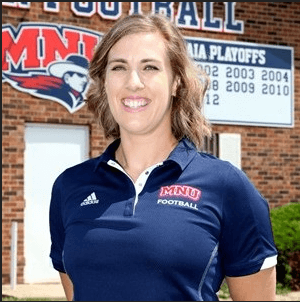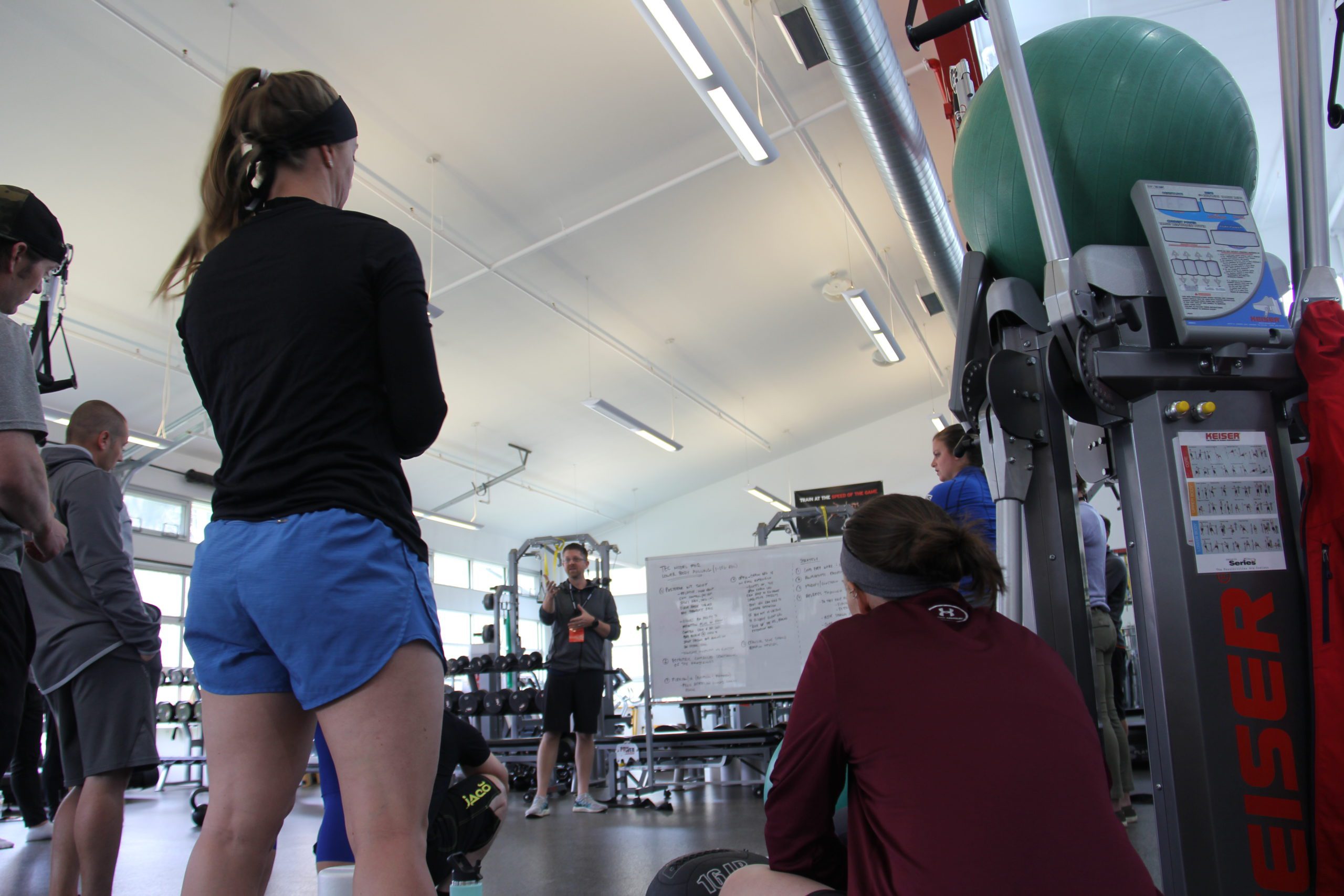Strength Training Program for Winter Break
Sports Performance | Strength & ConditioningABOUT THE AUTHOR

Whitney Rodden
Coach Rodden started out as a Softball player for MidAmerica Nazarene University (MNU) in 1997 and went on to participate in MNU’s Olympic Weightlifting Program. She graduated from MNU in 2001 with a Bachelor of Arts Degree in Athletic Training, and a Minor Degree in Psychology. In May of 2004 she graduated from Kansas State University (KSU) with a Master of Arts Degree in Education Administration and Leadership. She is a member of United States of America Weightlifting (USAW) at the Coach Level and Referee Level, a member of the National Athletic Training Association (NATA), a certified Collegiate Strength and Conditioning Coach (SCCC), and she is also a member of the National Strength and Conditioning Association (NSCA) in which she is a member and a Specialist. In July of 2005, Rodden Became the Head Strength and Conditioning Coach for MNU. She is the Strength and Conditioning Coach for Football, Men’s & Women’s Basketball, Men’s and Women’s Soccer, Volleyball, Softball, Baseball, and the Cheer Squad.
// How to Keep College Athletes Fit During Seasonal Breaks
Building a strength training program for winter break can be vital to keeping your athletes in tip top condition for the upcoming season. It is important to maintain proper technique and form during extended time off.
By the time the last few strength training sessions of the semester come around, I can tell most of the young athletes I coach are ready for a break. I can see it in their body language and written on their faces. Whether it’s the rigors of competition and practice, the stress of studying for finals, or a combination of both, many of them have already mentally checked out.


Finding the balance
While they need and deserve a mental break, the Christmas holiday can present some problems from an athletic standpoint. Sure, I don’t expect my lifters to train like maniacs while they’re away from campus, and, in fact, I hope they do enjoy some off days in which they do nothing but hang out with family and friends. But if they stop training completely, they’re going to start to see some declines in their power, strength, and speed after a week. Should they let things slide for the entire three-week break, they’re going to be in real trouble by the time they get back. Not with me, but with their bodies.
A long layoff like this can not only undo months of gains, but also leave you rusty from a technique standpoint. If you don’t do anything physical for that long, the sessions when you return are going to suck, and you’re going to be sore as heck after each one because you’ve detrained and you will no longer be used to the load. Not to mention the detrimental effects on performance for those lifters who also play one or more sports. Then there’s the competitive schedule to consider. Softball and baseball go hard as soon as their squads are back in January, and with competition for starting spots being tougher than ever, there’s no room for complacency and no time for players to work themselves back into shape.
The Power of Partial Lifts
With these considerations in mind (and, for the record, I always think about the health, sporting, and academic needs of my athletes when programming for them because the whole person is more important than how much they lift on the platform), I encourage players to do some kind of purposeful physical activity as often as possible while they’re gone. For my less experienced competitive lifters, I’ll deemphasize full clean and jerks and snatches and instead have them focus on partial variations like lift offs and rack pulls. There are a couple of reasons for this. First, there’s less chance of them injuring themselves while I’m not around to supervise them. Second, focusing on partial ranges of motion can help them get stronger and overcome sticking points so they’re actually more competent in the full lifts when they get back in my weight room come mid-January. I’ll also have them do compound lifts like deadlifts and front and back squats to keep their strength up.
If someone is a highly motivated and proficient lifter who’s targeting a late winter/early spring meet and then nationals afterward, I’ll usually have them stick to the same program we were working through up until the final day of classes. This way they can stay consistent, keep their snatches and clean and jerks smooth, and feel like they’re still progressing while they’re away. This isn’t merely a matter of competence, but also one of motivation. These lifters are typically single-minded, determined self-starters who don’t need me or any other coach around to push them.
Keep this in Mind
For athletes in other sports, I need to recognize that not everyone is as gung-ho as my competitive lifters. Also, many of them are going back to gyms that might not have Olympic lifting equipment, or will just be doing what they can at home. Some have also been through several months of a heavy competitive calendar. With all these factors and more realistic expectations in mind, I’ll typically prescribe some compound lifts if they’ll have the gear available to do them. If not, then the focus will be on bodyweight work like push-ups, pull-ups, and plyometrics. Before they leave campus, I design several different circuits that can be done for time, as many reps as possible, or in several other ways. I’ll encourage athletes to compete against their buddies on social media to foster healthy competition and help them all stay more motivated than they might if they were training solo. You’d be surprised how seriously some of them take these mini challenges.
Mobilize and Move
If a team is particularly beaten down by a lot of games before the holiday, then the focus will be on fitting in whatever movement they can and mobilizing every day. If they can utilize bands, rollers, and other tools consistently, then they’ll come back a little bit more mobile while also getting the recovery they need. For some of my athletes in the Kansas City area who are sticking around, our weight room is their home gym, and I’ll train with them or, in a few cases when I can’t be there, I’ll have campus security open up the facility so they can get some work in.
This time of year also gives me the opportunity to step away from the ins and outs of coaching full teams every day and put some real thought into planning for the rest of winter and on into spring. That way I’m fully prepared with detailed programming that can help my lifters meet or exceed their aims and also empower the other athletes to perform their best on game day. Rather than looking at the break as a time to lose ground, I see it as an opportunity to keep the momentum going and hopefully get at least some people back in even better shape than when they left campus and headed home. And for the rest, hopefully they’re close enough to where they were that we can pick up right where we left off and finish the year strong.
READY TO TRY TRAINHEROIC?
Our powerful platform connects coaches and athletes from across the world. Whether you are a coach or trainer looking to provide a better experience for your clients, or you’re an athlete looking for expert programming, click below to get started.
Want more training content?
More coaches and athletes than ever are reading the TrainHeroic blog, and it’s our mission to support them with the best training & coaching content. If you found this article useful, please take a moment to share it on social media, engage with the author, and link to this article on your own blog or any forums you post on.
Be Your Best,
TrainHeroic Content Team
HEROIC SOCIAL
HEROIC SOCIAL
TRAINING LAB
Access the latest articles, reviews, and case studies from the top strength and conditioning minds in the TH Training Lab

